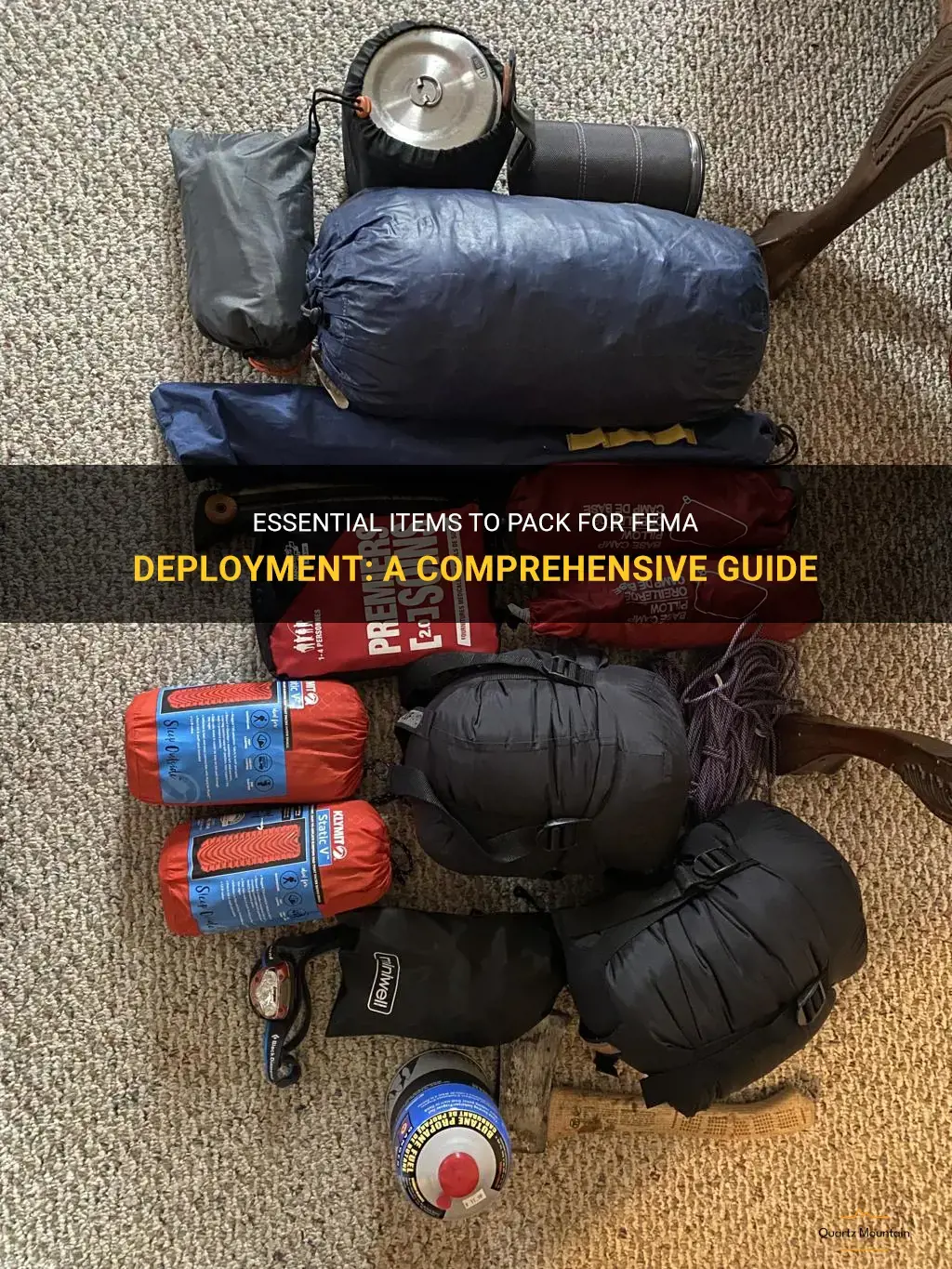
Are you a first responder or emergency management professional preparing for a FEMA deployment? If so, it's crucial to ensure you have all the essential items packed before heading out on your mission. In this comprehensive guide, we will walk you through the must-haves to bring with you, ensuring you are well-equipped to handle any situation that may come your way. From personal protective equipment to communication devices and everything in between, this guide has got you covered. So, let's dive in and make sure you're fully prepared for your FEMA deployment!
| Characteristics | Values |
|---|---|
| Clothing | - Comfortable, durable clothing suitable for long hours and varied weather conditions. - Extra sets of clothing for multi-day deployments. - Utilize clothing appropriate for specific deployment locations and conditions. |
| Footwear | - Sturdy, comfortable, closed-toe shoes or boots that provide good support and traction. - Waterproof boots for wet conditions. |
| Personal Protective Equipment (PPE) | - Hard hat - Safety glasses - Work gloves - High-visibility vest or clothing - N95 masks or respirators for dealing with hazardous materials or contaminated areas. |
| Hygiene and Personal Care | - Toiletries like toothbrush, toothpaste, soap, shampoo, and conditioner. - Towels and washcloths. - Hand sanitizer or hand wipes. - Feminine hygiene products, as needed. - Prescription medications and necessary medical supplies. |
| Bedding | - Sleeping bag or bedding for overnight stays in temporary shelters or field conditions. - Pillow or travel pillow. |
| Electronics | - Cell phone and charger. - Portable chargers or power banks. - Laptop or tablet, if needed for work. - Headphones or earbuds for communication and privacy. |
| Tools and Equipment | - Multi-tool or utility knife. - Flashlight or headlamp with spare batteries. - Duct tape or zip ties. - Rope or cordage. - Notepad and pens for taking notes. |
| Food and Water | - Non-perishable snacks or meal replacement bars. - Bottled water or water filtration system. - Reusable water bottle or hydration pack. |
| Documentation | - Personal identification documents. - Copy of FEMA deployment orders or paperwork. - Emergency contact information. - Insurance information. |
| Other Items | - Cash or debit/credit cards. - Maps or GPS device for navigation. - Entertainment items like books, playing cards, or portable games. - Insect repellent and sunscreen. - First aid kit. |
What You'll Learn
- What essential items should be packed for a FEMA deployment?
- Are there any specific clothing items or gear that are recommended for FEMA deployments?
- How much personal hygiene and toiletry items should be packed for a FEMA deployment?
- Are there any specific documents or paperwork that should be packed for a FEMA deployment?
- Are there any items that are prohibited or not recommended to bring on a FEMA deployment?

What essential items should be packed for a FEMA deployment?
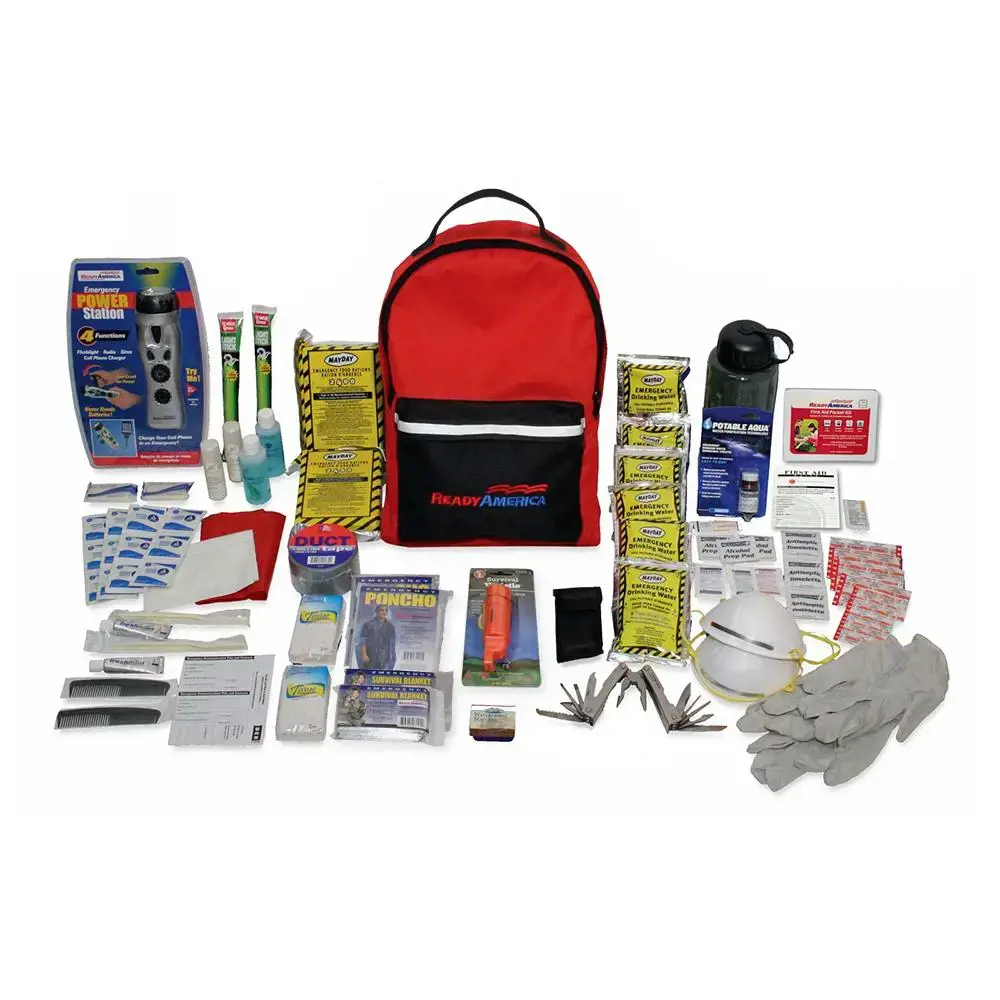
When preparing for a FEMA deployment, it is crucial to pack essential items that will help ensure your safety and effectiveness while on duty. Whether you are responding to a natural disaster or assisting with emergency management, having the right equipment and supplies can make a significant difference. In this article, we will discuss the essential items that should be included in your FEMA deployment packing list.
Personal Protective Equipment (PPE):
First and foremost, personal protective equipment is vital to safeguarding yourself from potential hazards during deployment. This includes items such as gloves, goggles, N95 masks, and high-visibility vests. PPE not only protects you from physical risks but also helps prevent the spread of diseases or contaminants.
Communication Devices:
Effective communication is crucial during a FEMA deployment. Pack a reliable communication device such as a two-way radio, cell phone, or satellite phone to stay connected with your team and receive information from the command center. Additionally, consider packing a portable charging device and extra batteries to ensure uninterrupted communication.
First Aid Kit:
Having a well-stocked first aid kit is essential in emergencies. Include band-aids, antiseptic wipes, pain relievers, and any prescribed medications you may need. Be prepared for minor injuries and illnesses to provide immediate care to yourself and others.
Weather-Appropriate Clothing:
FEMA deployments often encompass a range of environmental conditions. Pack appropriate clothing for different weather scenarios, including rain gear, thermal layers, and sun protection (hats, sunscreen, and sunglasses). Additionally, don't forget to include sturdy boots, work gloves, and extra socks to keep your feet dry and comfortable.
Food and Water:
During a FEMA deployment, access to food and water may be limited. Pack non-perishable food items such as energy bars, canned goods, and freeze-dried meals. Ensure you have an ample supply of bottled water or portable water filtration systems to stay hydrated.
Tools and Equipment:
Depending on your role in the deployment, you may require specific tools and equipment. This can include flashlights, multi-tools, duct tape, rope, work gloves, and a shovel. Assess the tasks you are likely to encounter and pack the tools accordingly.
Documentation and Identification:
Keep important documents such as your identification cards, deployment orders, and FEMA credentials readily available in a waterproof container. These documents will help facilitate smooth coordination and access to restricted areas.
Personal Hygiene Items:
Maintaining personal hygiene is critical for your well-being. Pack items such as hand sanitizer, wet wipes, toilet paper, and toiletries. These small essentials can significantly improve your comfort and prevent the spread of germs.
Sleeping Gear:
Depending on the deployment circumstances, you may need to sleep in temporary accommodations or shelters. Bring a sleeping bag, sleeping mat, and a pillow to ensure restful sleep amidst challenging conditions.
Miscellaneous Items:
Consider including additional items that might be useful on a FEMA deployment. These could be a notepad and pen for taking notes, a weather radio for staying informed, a camera for documenting evidence, and a travel-sized sewing kit for on-the-spot repairs.
Remember, every FEMA deployment is unique, so it is essential to tailor your packing list based on your specific situation and assignment. Check with your team leaders or coordinators for any additional items recommended for your deployment. Comprehensive preparation and packing will help ensure your success and effectiveness in serving communities during emergencies.
The Ultimate Packing Checklist for a 12-Day Vacation
You may want to see also

Are there any specific clothing items or gear that are recommended for FEMA deployments?
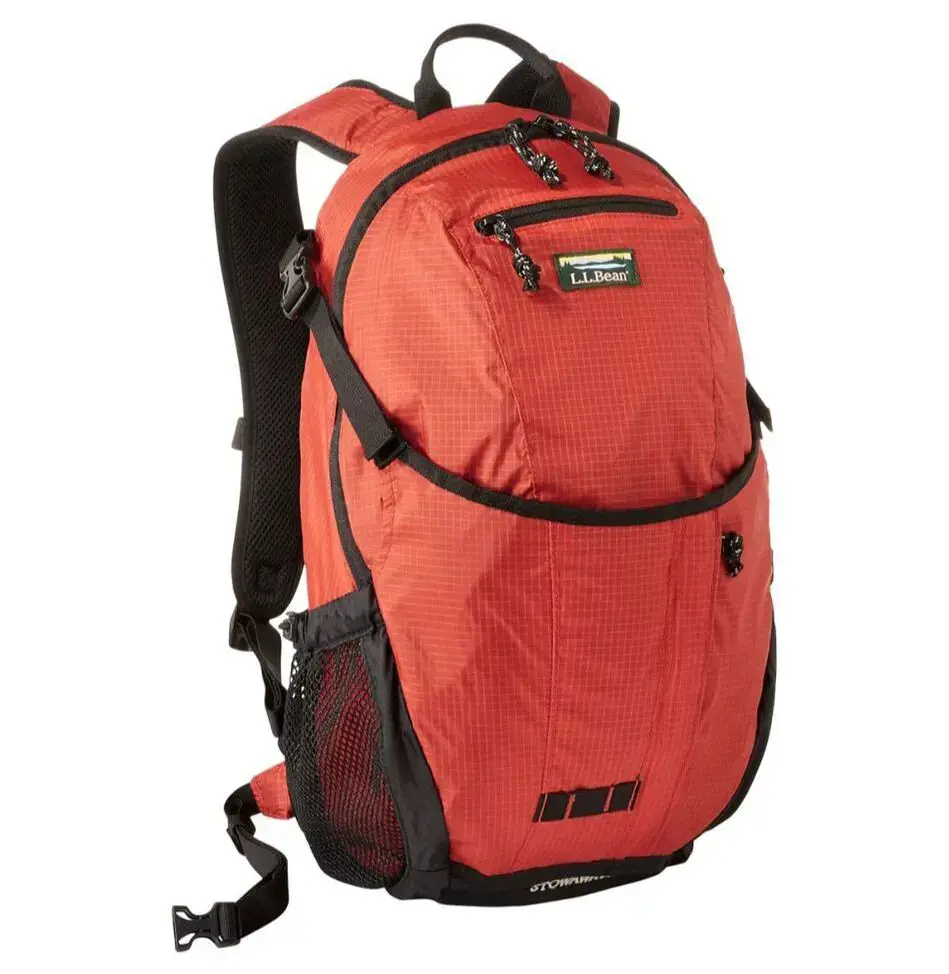
When it comes to FEMA deployments, it is important to come prepared with the right clothing and gear. The Federal Emergency Management Agency (FEMA) is responsible for responding to and managing disasters across the United States. From hurricanes and wildfires to floods and earthquakes, FEMA provides vital assistance and support during times of crisis.
While specific clothing and gear requirements may vary depending on the nature of the deployment and local conditions, there are some general recommendations that can help ensure the safety and effectiveness of FEMA personnel in the field.
Clothing: When working in disaster zones, it is essential to have clothing that is durable, comfortable, and suitable for various weather conditions. Here are some recommended clothing items:
- Boots: Sturdy, waterproof boots with good traction are essential for navigating uneven terrain and potentially hazardous conditions. Choose boots that provide ankle support and have slip-resistant soles.
- Pants: Opt for durable pants made from materials such as ripstop nylon or heavy-duty cotton. These fabrics are more resistant to tears and wear and tear.
- Shirts: Long-sleeved shirts made from moisture-wicking materials are preferable, as they help to keep the body cool and dry. Avoid wearing clothing made from cotton, as it retains moisture and can become uncomfortable.
- Jackets: Depending on the deployment location and weather conditions, it may be necessary to have both lightweight and heavy-duty jackets. Waterproof and wind-resistant outer layers are highly recommended.
- Hats: Wide-brimmed hats or baseball caps can provide protection from the sun and help keep the head cool. Additionally, a hat with a strap can ensure it stays in place during windy conditions.
Gear: In addition to appropriate clothing, FEMA personnel should have the right gear to carry out their roles effectively. Here are some essential gear items for FEMA deployments:
- Safety vest: A high-visibility safety vest is crucial for identification and visibility in disaster zones. It helps to distinguish FEMA personnel from other responders and provides an added layer of safety.
- Gloves: Durable gloves are essential for protecting hands from sharp objects, debris, and potential contaminants. Look for gloves that provide a good grip and are resistant to punctures and cuts.
- Headlamp or flashlight: In disaster zones, electricity may not be readily available. A headlamp or flashlight is essential for navigating in low-light conditions and conducting assessments and operations.
- First aid kit: A well-stocked first aid kit should be readily available at all times. It should include items such as bandages, antiseptics, pain relievers, and any necessary prescription medications.
- Communication devices: It is important to have reliable communication devices, such as two-way radios or satellite phones, for effective communication with other FEMA personnel and coordination of response efforts.
- Personal protective equipment (PPE): Depending on the nature of the deployment, FEMA personnel may need specific PPE, such as respiratory masks, eye protection, or chemical-resistant suits. These items protect against potential hazards and contaminants.
These recommendations serve as a starting point for the clothing and gear needed for FEMA deployments. It is essential for individuals to familiarize themselves with specific deployment requirements and consult with their teams and supervisors for any additional recommendations.
Additionally, it is crucial to periodically inspect and maintain clothing and gear to ensure they are in good condition and ready for deployment. Regularly check for any tears, worn-out soles, or expired items in the first aid kit.
In conclusion, having the right clothing and gear is essential for FEMA personnel during deployments. By being prepared with appropriate clothing and gear, FEMA responders can perform their duties safely and effectively, providing much-needed assistance to those affected by disasters.
Example:
During a recent FEMA deployment to a flood-affected area, Joe, a FEMA team member, found himself in the thick of the disaster. He was wearing sturdy boots, durable pants, a moisture-wicking shirt, and a waterproof jacket. The boots provided traction and support as he waded through the waterlogged streets, while the durable pants protected him from sharp objects and debris. The moisture-wicking shirt kept him cool and dry as he worked tirelessly, and the waterproof jacket kept him protected from the relentless rain. Additionally, Joe wore a wide-brimmed hat, which shielded him from the sun during brief breaks in the storm. Equipped with a high-visibility safety vest, gloves, and a headlamp, Joe was able to carry out his duties effectively and safely. The communication devices helped him stay connected with his team, while the first aid kit provided immediate medical assistance to those in need. Joe's clothing and gear were instrumental in his ability to respond and provide support during this challenging FEMA deployment.
Overall, having the right clothing and gear is essential for FEMA deployments. The recommendations mentioned above provide a foundation for preparing for these deployments. By following these guidelines and staying informed about specific deployment requirements, FEMA responders can be better equipped to provide aid and support during times of crisis.
The Ultimate Guide to Packing Your Carry-On Bag for Any Trip
You may want to see also

How much personal hygiene and toiletry items should be packed for a FEMA deployment?
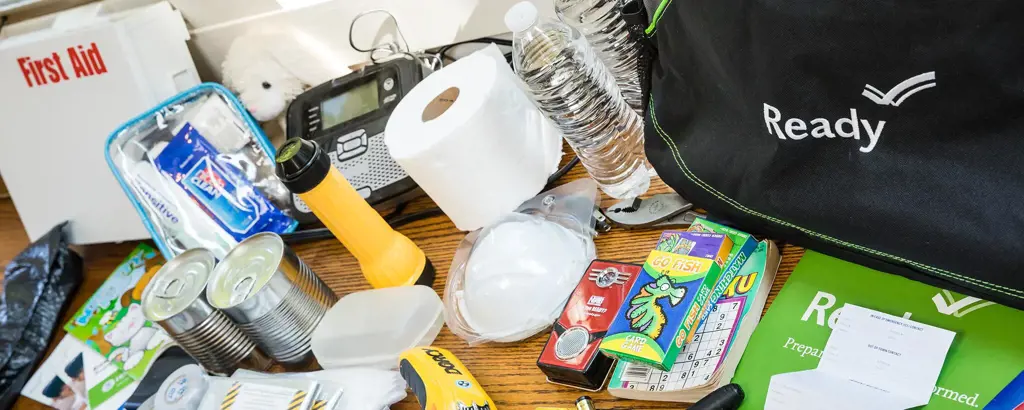
Personal hygiene and toiletry items are essential when it comes to a FEMA deployment. Being prepared with the right supplies can make a big difference in maintaining good hygiene and overall well-being during a challenging time. In this article, we will discuss how much of these items should be packed for a FEMA deployment, considering scientific recommendations, experiences from previous deployments, step-by-step planning, and providing examples of essential items.
Scientific recommendations:
When it comes to personal hygiene and toiletry items, it is essential to follow scientific guidelines to maintain cleanliness and prevent the spread of diseases. According to the Centers for Disease Control and Prevention (CDC), the basic hygiene items that should be packed include toothpaste, toothbrushes, soap or body wash, shampoo, conditioner, razors, and toilet paper. These items should be carried in an adequate quantity to last for the duration of the deployment, considering the frequency of use and personal preference.
Experiences from previous deployments:
Experienced FEMA personnel and volunteers who have been on deployments can provide valuable insights into the amount of personal hygiene and toiletry items that should be packed. From their experiences, it is recommended to pack at least a two-week supply of these items for a FEMA deployment. This ensures that there is enough for daily use without the need to constantly worry about running out of essential hygiene supplies.
Step-by-step planning:
To determine how much personal hygiene and toiletry items to pack for a FEMA deployment, it is important to consider the following steps:
Step 1: Assess the length of the deployment - Determine the estimated duration of the deployment to have a clear idea of how long the supplies need to last.
Step 2: Calculate the frequency of use - Consider how often each item will be used. For example, toothpaste and soap are typically used daily, while shampoo and conditioner may be used every other day.
Step 3: Estimate the quantity required per use - Consider the amount of each item typically used during one application. For example, toothpaste may require a pea-sized amount, while body wash may require a quarter-sized amount.
Step 4: Multiply the frequency of use by the quantity required per use - This will give an estimate of the amount of each item needed daily.
Step 5: Multiply the daily quantity by the number of days in the deployment - This will provide an approximate amount of each item that should be packed for the entire duration of the deployment.
Examples of essential items:
Based on scientific recommendations and experiences, the following examples highlight essential personal hygiene and toiletry items that should be packed for a FEMA deployment:
- Toothpaste and toothbrushes: Pack at least two tubes of toothpaste and two toothbrushes per person for a two-week deployment.
- Soap or body wash: Carry enough to last for daily use, estimating the quantity required per day.
- Shampoo and conditioner: Depending on individual needs, pack a sufficient amount to last for the duration of the deployment.
- Razors: Carry an adequate supply for shaving needs.
- Toilet paper: It is recommended to pack at least two rolls per person for a two-week deployment.
In conclusion, packing an adequate amount of personal hygiene and toiletry items is crucial when preparing for a FEMA deployment. By following scientific recommendations, considering experiences from previous deployments, and following step-by-step planning, individuals can ensure they have enough supplies to maintain good hygiene and overall well-being throughout their deployment.
Essential Packing List for a Two-Week Trip
You may want to see also

Are there any specific documents or paperwork that should be packed for a FEMA deployment?
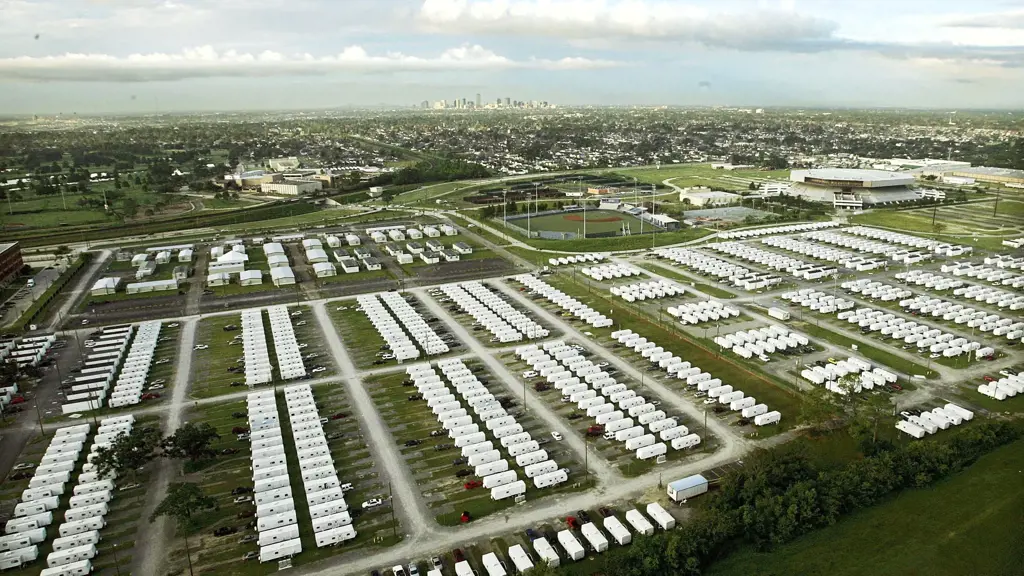
When preparing for a FEMA deployment, there are several documents and paperwork that should be packed to ensure a smooth and efficient operation. These documents are essential for both personal and professional reasons and will help you navigate the deployment process effectively. In this article, we will discuss the specific documents that should be packed for a FEMA deployment.
- Personal Identification Documents: It is crucial to carry your personal identification documents, such as a driver's license, passport, and Social Security card. These documents are needed for identification purposes, both during the deployment process and for personal needs while you are away from home.
- Emergency Contact Information: Make sure to have a list of emergency contacts, including family members, close friends, and your home address. This information will be required in case of any emergencies or to contact your loved ones during your deployment.
- FEMA Credentialing Documents: FEMA has specific credentialing requirements for its employees, and you should have copies of these documents readily available. These could include your FEMA identification badge, deployment orders, and any other relevant documentation related to your position and role within FEMA.
- Medical Documents: Bringing a copy of your medical records, including any prescribed medications and insurance information, is crucial during a deployment. It is essential to have these documents in case of an emergency or if you need to seek medical attention while away from home.
- Personal Financial Documents: It is advisable to carry important financial documents, such as credit cards, debit cards, and an emergency cash reserve. These will be useful in managing your day-to-day expenses during the deployment.
- Professional Certifications: If you have any professional certifications or licenses relevant to your FEMA role, it is important to pack copies of these documents. These certifications may include qualifications in emergency management, logistics, or other specific areas.
- Deployment Handbook: FEMA often provides a deployment handbook to its employees, which contains valuable information about the location, housing, transportation, and other important details. Make sure to bring a copy of this handbook for reference throughout your deployment.
- Emergency Response Plans: Depending on your role within FEMA, it may be necessary to have copies of emergency response plans, including evacuation routes, communication protocols, and incident management procedures. These plans are crucial for ensuring a coordinated response during a disaster or emergency situation.
While this list provides a general overview of the important documents and paperwork that should be packed for a FEMA deployment, it is important to remember that specific requirements may vary based on your role and the nature of the deployment. It is always a good idea to consult with your supervisor or the relevant FEMA departments to ensure you have all the necessary documents packed before heading out on a deployment.
In conclusion, packing the right documents and paperwork is essential for a successful FEMA deployment. Personal identification documents, emergency contacts, FEMA credentials, medical records, financial documents, professional certifications, deployment handbooks, and emergency response plans are all crucial documents to have on hand. By properly preparing and organizing these documents, you can ensure a smooth and efficient deployment process and be well-prepared for any situation that may arise.
Essential Items for a Two-Week Trip to Thailand: Your Packing Guide
You may want to see also

Are there any items that are prohibited or not recommended to bring on a FEMA deployment?
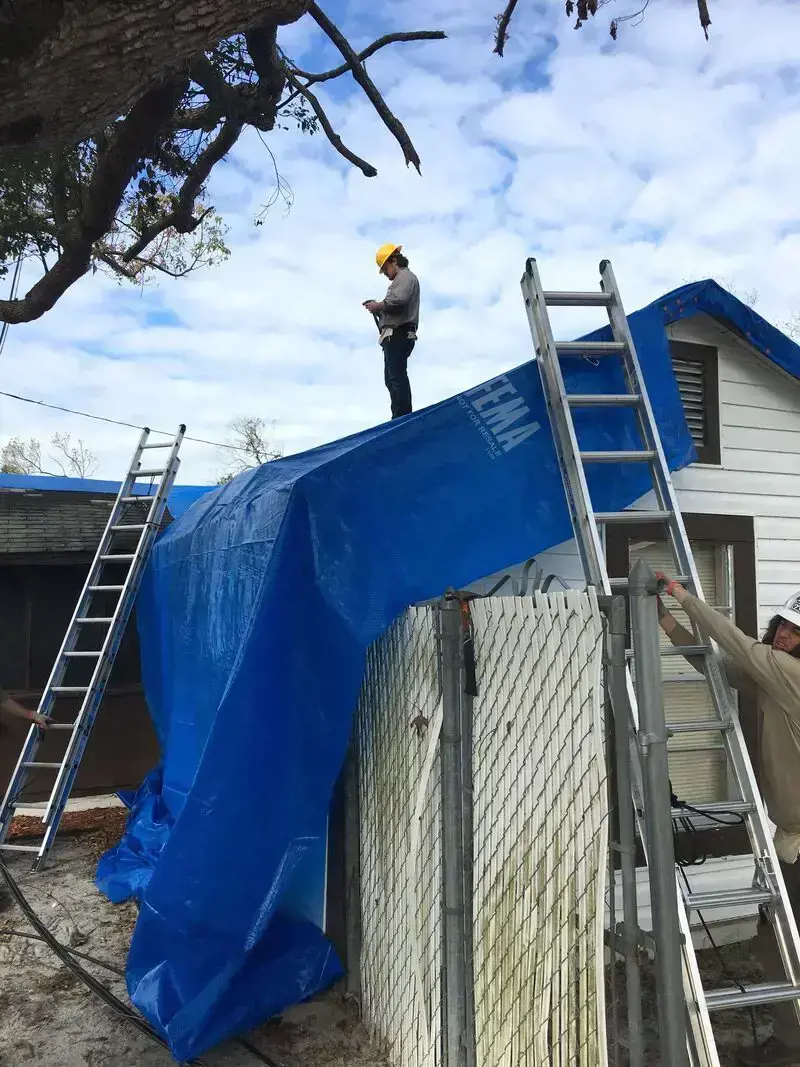
When preparing for a FEMA deployment, it is important to know which items are prohibited or not recommended to bring. This is because certain items may pose a safety threat, create a distraction, or hinder your ability to effectively perform your duties. Additionally, space is often limited, so packing only essential items is crucial. Here are some items that are generally not allowed or discouraged on a FEMA deployment:
Weapons and Firearms:
It is strictly prohibited to bring weapons and firearms on a FEMA deployment. This includes guns, knives, tasers, and any other items that can be used as potential weapons. The only exception to this rule is law enforcement officers who are required to carry a firearm as part of their duty.
Illegal Drugs:
Bringing illegal drugs or substances on a FEMA deployment is not only illegal, but it can also jeopardize the safety and effectiveness of the entire team. As a FEMA responder, it is essential to maintain a clear state of mind and be able to make quick and accurate decisions.
Alcohol:
While alcohol may be permissible in some limited instances, it is generally discouraged, especially during work hours. FEMA deployments often involve demanding and stressful situations, and consuming alcohol can impair judgment, coordination, and overall performance. It is always best to avoid alcohol during a deployment unless explicitly authorized.
Personal Vehicles:
Bringing a personal vehicle on a FEMA deployment is generally not recommended. Deployments often involve long hours, unpredictable schedules, and limited parking availability. FEMA typically provides transportation to responders, and having a personal vehicle can create unnecessary logistical challenges and expenses.
Excessive Personal Belongings:
Space is often limited on FEMA deployments, especially in shared accommodations or emergency response vehicles. Bringing excessive personal belongings can create clutter, make it difficult to navigate, and impede the effectiveness of the team. Pack only the essentials and avoid bringing unnecessary items that can be easily obtained on-site.
It is important to note that these recommendations and restrictions may vary depending on the specific deployment and the guidelines set by the FEMA leadership. Always check with your supervisor or deployment coordinator for any specific guidelines or restrictions before packing for a FEMA deployment.
In conclusion, when preparing for a FEMA deployment, it is crucial to consider the safety, efficiency, and overall well-being of the team. By following the guidelines and being mindful of the prohibited or not recommended items, you can ensure a smooth and successful deployment.
Essential Items to Pack for an Emergency Situation
You may want to see also
Frequently asked questions
When packing for a FEMA deployment, it is important to pack essentials such as clothing, toiletries, and personal items. Additionally, you should pack any required equipment or tools for your specific role or assignment. It is also advisable to bring any necessary medications and important documents such as your driver's license and identification.
While FEMA provides meals and water for its deployed personnel, it is always a good idea to have some non-perishable food items and a reusable water bottle with you. This is especially important in case of emergencies or situations where access to food and water may be limited.
When packing clothing for a FEMA deployment, it is important to consider the location, weather conditions, and the specific tasks you will be involved in. Generally, it is recommended to pack comfortable and durable clothing such as t-shirts, long-sleeve shirts, pants, and sturdy shoes. It is also a good idea to pack a raincoat or waterproof jacket, as well as extra socks and underwear.
While FEMA deployments can be demanding and challenging, it is important to take care of your mental well-being as well. Bringing personal items or forms of entertainment such as books, games, or a hobby equipment can help you relax during downtime and relieve stress. However, it is important to prioritize essential items and not overpack.
When packing for a FEMA deployment, it is important to prioritize essential items and keep your luggage lightweight and manageable. Avoid packing bulky or unnecessary items that may take up space and add unnecessary weight. It is also advisable to leave behind any valuables or sentimental items that could be at risk of loss, damage, or theft during the deployment.







